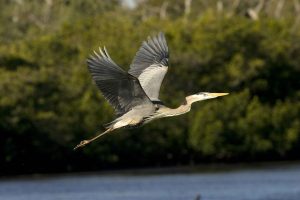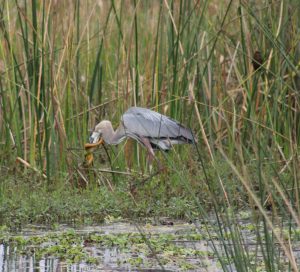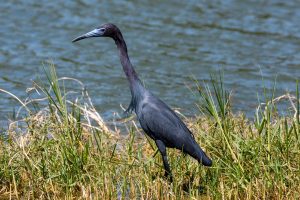Herons
The likely mascot of your neighborhood pond, herons belong to the Family Ardeidae, of which there are around 70 different species of herons, egrets, and bitterns worldwide.
Dive in to learn more about the herons of Florida, or navigate to our Florida Wildlife webpage to watch our Wild Sarasota webinars on Herons and Cranes, Egrets, and Other Wading Birds for a more in depth look.
What is a Heron?… Well, that’s as clear as mud

The terms “heron” and “egret” are often used interchangeably, and for good reason. Taxonomically, there is not much of a difference between the two groups of birds. Herons, egrets, and bitterns belong to the same Order Pelecaniformes and Family Ardeidae. The term “egret” is often used to to describe white-feathered wading birds, although of course there are always exceptions. The white-feathered American Ibis is in a different Family, the immature form of the Little Blue Heron is completely white, and the white form of the Great Blue Heron, sometimes called a “Great white heron”, is found nearly exclusively in shallow marine waters along coast of southern Florida, the Yucatan Peninsula, and in the Caribbean. Add to that confusion, the Reddish Egret that is in the same genus as the Little Blue and Tricolored Herons. Clear as mud.
Generally, the herons we are most familiar with are large to medium, long-legged wading birds of the water’s edge. Yet, some subgroups seem distinct…. bitterns are solitary marsh-dwellers with notable voices; and night-herons are most active at night, when other herons are roosting.
Appearance, Behavior and More

Even if you’re not a birder, so iconic to Florida, herons seemed to be loved by all. Maybe this is due to their patience and poise, or their beautifully unique color schemes ranging from black, grey, blue, and green.
For the most part, herons do share many physical and behavioral commonalities. One shared physical characteristic would be their long S-shaped neck that is incredibly adapted to their diet and lifestyle. Their diet includes small fish, lizards, snakes, frogs, and an occasional insect. Their long necks allow them to use their dagger-like beaks as a spear, darting their heads down towards prey at great speeds.
Herons are a patient and typically solitary predator, utilizing a variety of hunting strategies. This involves either standing or perching near the water’s edge waiting to spear their prey. Or, you may see a heron speedily walking through a wetland habitat, stirring up the ground floor with its feet. This is meant to startle its prey, making for an easier target.
Common Florida Herons

Arguably North America’s most well-known heron, the Great Blue Heron (Ardea herodias) is the largest heron in North America. They can reach up to 4 feet tall with a wingspan up to 6.5 feet. Often spotted near wetlands, rivers, ditches, and almost anywhere with a pond. The Great Blue Heron is quite majestic as it demonstrates poise, slowly moving and not seeming to mind all of the people admiring its beautiful blue-gray plumage.

Besides the Great Blue Heron, the other most commonly seen herons locally are easily confused with each other. Both medium sized herons found in similar habitats, the Little Blue and Tri-colored Herons can both appear bluish. The Little Blue Heron (Egretta caerulea) tends to be darker blue, almost purplish with a blue beak tipped in black and dark legs. Immature Little Blue Herons will be white initially and may be mottled white and dark blue until molting into their adult plumage.

The Tri-colored Heron (Egretta tricolor) has a white streak down its neck and a white chest and belly with a yellow beak and legs.

Less commonly seen, the smaller Green Heron (Butorides virescens) can be found in almost any wetland with vegetation, and even along boat mooring ropes where it will perch waiting for fish to snag. This is one of the few species of birds in the world that actually uses a tool to catch prey. The Green Heron will make a fishing lure out of feathers, insects, or even bread crusts and drop it on the water’s surface to attract small fish. They hold their neck and head close to their bodies, but can stretch out their neck when needed to catch their prey.

Rarely seen during the day are the Black-crowned and Yellow-crowned Night Herons. Black-crowned Night Herons (Nycticorax nycticorax) do most of their feeding at night, spending most of the day hunched between leaves and branches. A smaller heron with stockier body parts in comparison to other herons, they can be easily identified by a long, white head plume and their black back and top of the head that contrasts against their white and grey body.
Protect our Herons

Remember, herons need wetland habitats to survive and depend on bodies of water for a source of food. Habitat loss is the primary human-caused threat to herons. A growing heron population indicates ecological health as they forage forage for food within these wetland habitats.
Never feed herons, egrets, cranes, wood storks, or any bird human food. Not only is this detrimental to their nutrition, they can also become reliant on humans for food which endangers their safety as they grow accustomed to hanging out on roads and in neighborhoods, or causes starvation if the human no longer is available to provide them food. These birds are also protected species and it is illegal to purposefully feed them human food. Please enjoy these majestic species with your eyes, binoculars, and cameras; keeping a respectful distance so as not to disturb their daily lives within our ecosystems.
To Learn More About Herons and Cranes:
- Watch our Wild Sarasota webinar: Herons and Cranes, and other bird webinars on our Florida Wildlife webpage.
- Enjoy information about a variety of bird species at Cornell Lab of Ornithology’s All About Birds website.
- Don’t forget to visit our local Sarasota Audubon Society and Venice Area Audubon Society.
Read all our Wild Sarasota blogs HERE
 1
1
